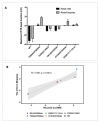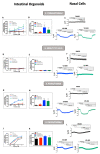Personalized Medicine Based on Nasal Epithelial Cells: Comparative Studies with Rectal Biopsies and Intestinal Organoids
- PMID: 34065744
- PMCID: PMC8156700
- DOI: 10.3390/jpm11050421
Personalized Medicine Based on Nasal Epithelial Cells: Comparative Studies with Rectal Biopsies and Intestinal Organoids
Abstract
As highly effective CFTR modulator therapies (HEMT) emerge, there is an unmet need to find effective drugs for people with CF (PwCF) with ultra-rare mutations who are too few for classical clinical trials and for whom there are no drug discovery programs. Therefore, biomarkers reliably predicting the benefit from CFTR modulator therapies are essential to find effective drugs for PwCF through personalized approaches termed theranostics. Here, we assess CFTR basal function and the individual responses to CFTR modulators in primary human nasal epithelial (pHNE) cells from PwCF carrying rare mutations and compare these measurements with those in native rectal biopsies and intestinal organoids, respectively, in the same individual. The basal function in pHNEs shows good correlation with CFTR basal function in rectal biopsies. In parallel, CFTR rescue in pHNEs by CFTR modulators correlates to that in intestinal organoids. Altogether, results show that pHNEs are a bona fide theranostic model to assess CFTR rescue by CFTR modulator drugs, in particular for PwCF and rare mutations.
Keywords: CFTR; CFTR modulators; human nasal epithelial cells; intestinal organoids; rectal biopsies; theranostic.
Conflict of interest statement
The authors declare no conflict of interest.
Figures




Similar articles
-
Personalized medicine: Function of CFTR variant p.Arg334Trp is rescued by currently available CFTR modulators.Front Mol Biosci. 2023 Mar 17;10:1155705. doi: 10.3389/fmolb.2023.1155705. eCollection 2023. Front Mol Biosci. 2023. PMID: 37006619 Free PMC article.
-
Correction of CFTR function in intestinal organoids to guide treatment of cystic fibrosis.Eur Respir J. 2021 Jan 5;57(1):1902426. doi: 10.1183/13993003.02426-2019. Print 2021 Jan. Eur Respir J. 2021. PMID: 32747394
-
Theratyping of the Rare CFTR Variants E193K and R334W in Rectal Organoid-Derived Epithelial Monolayers.J Pers Med. 2022 Apr 14;12(4):632. doi: 10.3390/jpm12040632. J Pers Med. 2022. PMID: 35455747 Free PMC article.
-
Theranostics vs theratyping or theranostics plus theratyping?J Cyst Fibros. 2025 Jan;24(1):10-15. doi: 10.1016/j.jcf.2024.09.013. Epub 2024 Sep 25. J Cyst Fibros. 2025. PMID: 39327193 Review.
-
Individualized medicine using intestinal responses to CFTR potentiators and correctors.Pediatr Pulmonol. 2016 Oct;51(S44):S23-S34. doi: 10.1002/ppul.23553. Pediatr Pulmonol. 2016. PMID: 27662101 Review.
Cited by
-
Molecular Dynamics and Theratyping in Airway and Gut Organoids Reveal R352Q-CFTR Conductance Defect.Am J Respir Cell Mol Biol. 2022 Jul;67(1):99-111. doi: 10.1165/rcmb.2021-0337OC. Am J Respir Cell Mol Biol. 2022. PMID: 35471184 Free PMC article.
-
Absence of EPAC1 Signaling to Stabilize CFTR in Intestinal Organoids.Cells. 2022 Jul 25;11(15):2295. doi: 10.3390/cells11152295. Cells. 2022. PMID: 35892592 Free PMC article.
-
New drugs in cystic fibrosis: what has changed in the last decade?Ther Adv Chronic Dis. 2022 May 21;13:20406223221098136. doi: 10.1177/20406223221098136. eCollection 2022. Ther Adv Chronic Dis. 2022. PMID: 35620188 Free PMC article. Review.
-
A new platform for high-throughput therapy testing on iPSC-derived lung progenitor cells from cystic fibrosis patients.Stem Cell Reports. 2021 Nov 9;16(11):2825-2837. doi: 10.1016/j.stemcr.2021.09.020. Epub 2021 Oct 21. Stem Cell Reports. 2021. PMID: 34678210 Free PMC article.
-
In silico analysis and theratyping of an ultra-rare CFTR genotype (W57G/A234D) in primary human rectal and nasal epithelial cells.iScience. 2023 Oct 12;26(11):108180. doi: 10.1016/j.isci.2023.108180. eCollection 2023 Nov 17. iScience. 2023. PMID: 38026150 Free PMC article.
References
-
- Elborn J.S., Davies J., Mall M.A., Flume P.A., Plant B. Current strategies for the long-term assessment, monitoring, and management of cystic fi brosis patients treated with CFTR modulator therapy. J. Cyst. Fibros. 2016;16:11–12. - PubMed
Grants and funding
LinkOut - more resources
Full Text Sources
Research Materials

